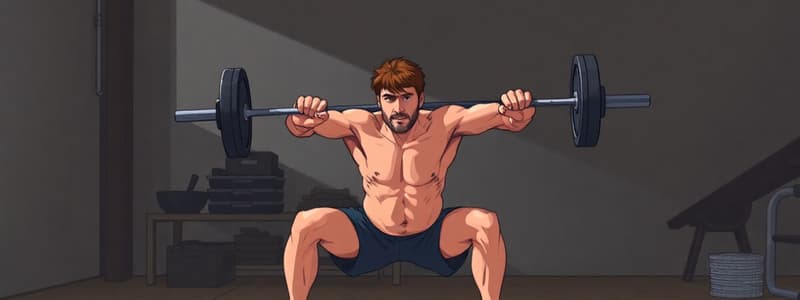Podcast
Questions and Answers
What is involved in assessing hip flexion in athletes?
What is involved in assessing hip flexion in athletes?
- Lifting the thigh above the waist level
- Pushing the thigh away from the chest
- Rotating the thigh outward
- Pulling the thigh toward the chest (correct)
What should be done to improve range of motion if mobility restrictions are present?
What should be done to improve range of motion if mobility restrictions are present?
- Only stretching techniques must be used
- Myofascial release is ineffective
- A variety of techniques can be employed (correct)
- No changes are needed
How should an athlete be positioned to assess lumbar-spine extension?
How should an athlete be positioned to assess lumbar-spine extension?
- Standing upright with hands on hips
- Lying prone with upper body on forearms (correct)
- Lying supine with legs elevated
- Sitting with feet flat on the ground
What is a sign of dysfunctional lumbar-spine extension?
What is a sign of dysfunctional lumbar-spine extension?
What may vary greatly among individuals regarding mobility improvement?
What may vary greatly among individuals regarding mobility improvement?
What indicates excessive extension at the lumbar-spine junction?
What indicates excessive extension at the lumbar-spine junction?
Which of the following is true about assessing range of motion?
Which of the following is true about assessing range of motion?
Why is thoracic-spine extension important in squat variations?
Why is thoracic-spine extension important in squat variations?
What should be employed to improve squat mechanics in athletes with motor control issues?
What should be employed to improve squat mechanics in athletes with motor control issues?
Common misconceptions among athletes regarding squat errors often relate to which of the following?
Common misconceptions among athletes regarding squat errors often relate to which of the following?
What can limit an athlete's squat performance despite having mobility?
What can limit an athlete's squat performance despite having mobility?
Which aspect becomes increasingly important during the overhead squat?
Which aspect becomes increasingly important during the overhead squat?
What should trainers avoid assuming about athletes who claim they have squat issues?
What should trainers avoid assuming about athletes who claim they have squat issues?
What is often the response from an athlete when presented with a cue to improve their squat mechanics?
What is often the response from an athlete when presented with a cue to improve their squat mechanics?
What role does shoulder mobility play in squat variations?
What role does shoulder mobility play in squat variations?
What should athletes engage to assume a more neutral position during a squat?
What should athletes engage to assume a more neutral position during a squat?
What common fault might athletes experience during a squat related to balance?
What common fault might athletes experience during a squat related to balance?
What is suggested to assist athletes struggling with weight distribution during squats?
What is suggested to assist athletes struggling with weight distribution during squats?
Which of the following is a method for teaching proper squat positioning?
Which of the following is a method for teaching proper squat positioning?
How can reducing or eliminating weight assist an athlete during squats?
How can reducing or eliminating weight assist an athlete during squats?
What aspect of squat technique do athletes often wrongly perceive to be caused by limited mobility?
What aspect of squat technique do athletes often wrongly perceive to be caused by limited mobility?
What advantage does proper weight distribution provide in squat technique?
What advantage does proper weight distribution provide in squat technique?
What occurs when an athlete's pelvis is poorly oriented during the squat setup?
What occurs when an athlete's pelvis is poorly oriented during the squat setup?
What is the recommended stance width for an air squat?
What is the recommended stance width for an air squat?
Which position should the athlete's weight be distributed during an air squat?
Which position should the athlete's weight be distributed during an air squat?
What should the athlete avoid when beginning the squat movement?
What should the athlete avoid when beginning the squat movement?
What is the correct position of the spine during the air squat?
What is the correct position of the spine during the air squat?
At what point should the athlete's hip crease be relative to their kneecap during the squat?
At what point should the athlete's hip crease be relative to their kneecap during the squat?
What action completes the air squat movement?
What action completes the air squat movement?
Which of the following best describes the athlete's core position during the squat?
Which of the following best describes the athlete's core position during the squat?
Flashcards are hidden until you start studying
Study Notes
Air Squat Points of Performance
- The squat is a foundational movement in CrossFit, requiring proper mobility and motor control.
- During setup, athletes should have a shoulder-width stance, knees and hips fully extended, and weight on their heels.
- Maintain a braced core and chest up to position the spine in neutral.
- The movement begins by moving the hips down and back, not forward.
- Descend until the hip crease is below the knee cap while keeping the knees over the feet and spine in a neutral position.
- Return to a fully upright position with extended hips and knees.
Mobility Assessment and Techniques
- Mobility restrictions can be addressed through stretching, myofascial release, joint mobilizations, and manual therapy.
- To assess lumbar-spine extension, have the athlete lie prone and prop their upper body on their forearms.
- Uniform extension through the lumbar spine should be observed with hips flat on the ground.
- If hips rise off the ground or excessive extension at one spinal segment occurs, it indicates dysfunctional lumbar-spine extension.
- Thoracic-spine extension and shoulder mobility are crucial for various squat variations, with their importance increasing in the overhead squat.
Motor Control and Squat Performance
- Motor control issues arise when an athlete has proper mobility but struggles with squat performance.
- These issues indicate an inability to coordinate muscle activation to control movement through available ranges of motion.
- Verbal, visual, and tactile cues should be used to improve mechanics for athletes with motor control limitations.
- Many athletes initially struggle with balance during a squat, leading to loss of neutral spine, weight shift onto toes, excessive knee movement, and a lack of depth.
- Proper weight distribution is crucial for a stable squat foundation, similar to a building needing a well-distributed base.
- Cues like pushing hips down and back while maintaining heel weight can aid in correcting squat form.
- Use of weights like kettlebells or light plates can provide counterbalance assistance to improve positioning.
Studying That Suits You
Use AI to generate personalized quizzes and flashcards to suit your learning preferences.




